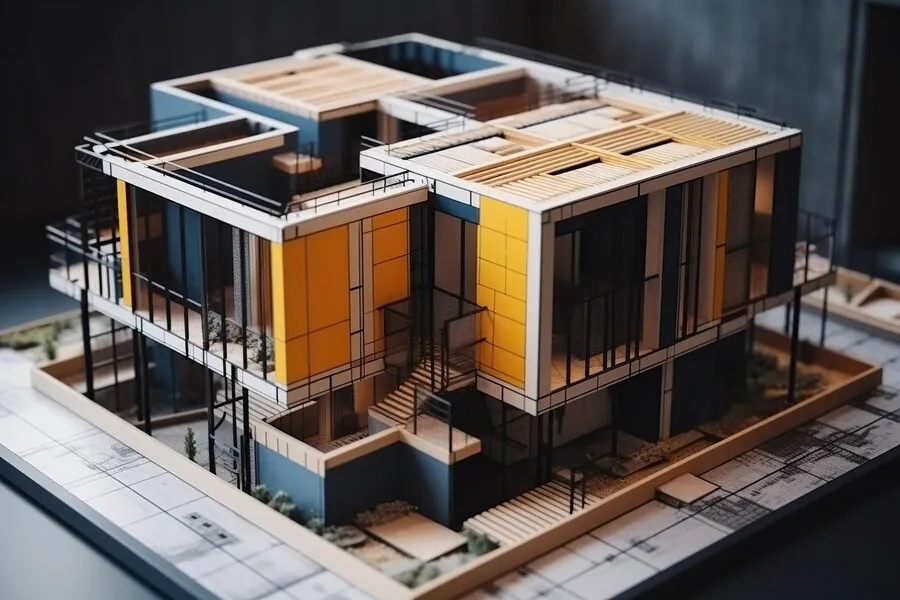The embrace of sustainability and innovative aesthetics marks the embarkation into modern residential design. Innovations in this field are reshaping homes to reflect the contemporary lifestyle, focusing more on environmental responsibility and energy efficiency. Homeowners are now more aware of the long-term impacts of their residential design choices on their immediate surroundings and the broader environment.
Emerging Elements in Modern Home Design
The modern home has evolved into a nexus of comfort, efficiency, and intelligent living. Advances in home automation technology have enabled residents to efficiently manage their living environments with the touch of a button or voice command. Whether it’s adjusting the thermostat, monitoring security, or controlling lighting, technology has become an intrinsic part of the contemporary household. This technological revolution in homes is complemented by a minimalist design aesthetic that espouses clean lines and uncluttered spaces. The result is visually appealing and mentally soothing homes, free of unnecessary distractions. Additionally, residential building design has embraced sustainability principles, incorporating passive solar design, energy-efficient appliances, and sustainable materials to minimize environmental impact and reduce utility costs. Biophilic design, incorporating natural elements like daylight and greenery into living spaces, has gained traction as inhabitants seek to forge a deeper connection with nature.
The Rise of Eco-Friendly Building Materials
Eco-friendly building materials, like bamboo, reclaimed wood, and recycled metal and glass, are setting new standards in residential construction, reflecting a collective shift towards environmentally conscious practices. These durable materials promote healthier indoor air quality and offer versatility in design. Modern construction prioritizes energy-efficient features such as high-quality insulation to stabilize interior temperatures and reduce reliance on heating and cooling systems, thus cutting energy costs. Green roofs and living walls, which reduce stormwater runoff and enhance insulation, are increasingly popular eco-conscious trends in construction. Commercial building design also follows suit, emphasizing sustainability, energy efficiency, and innovative solutions to create environmentally responsible structures that prioritize functionality and environmental stewardship. Commercial building design also adapts to meet the demand for sustainable and energy-efficient structures. Architects and developers are incorporating features such as passive solar design, efficient HVAC systems, and advanced lighting controls to reduce energy consumption and minimize the carbon footprint of commercial properties. Additionally, integrating intelligent building technologies allows for real-time energy usage monitoring and optimization, further enhancing efficiency and sustainability. These initiatives not only benefit the environment but also contribute to cost savings for businesses over the long term, making sustainable commercial buildings an intelligent investment for the future.
Maximizing Space: Multi-Functional Rooms and Open-Plan Layouts
The concept of multi-functional spaces has revolutionized interior design by allowing rooms to serve multiple purposes. A single space can effortlessly transition from a home office to an exercise area to a relaxation nook, thanks to movable partitions, foldable furniture, and intelligent design. Open-plan layouts support this versatility by creating an expansive feel and fostering a seamless flow between different zones within the home. These open spaces call for innovative storage solutions—think wall-mounted units, hidden compartments, and multi-use fixtures—which are particularly important in urban homes where space is at a premium. These design solutions help maintain an orderly and spacious environment by offering a place for everything, enabling occupants to enjoy the openness without sacrificing functionality.
Enhancing Outdoor Living Areas for Year-Round Use
Outdoor living areas are increasingly seen as extensions of the interior living space, with homeowners investing in covered patios, outdoor heating solutions, and weatherproof furnishings to make year-round outdoor entertaining a reality. These spaces increase the available living space and enrich the home living experience by inviting residents to spend more time in natural environments. Landscape design plays a crucial role in bridging indoor and outdoor spaces, often dictating the style and functionality of the exterior areas. A well-considered landscape plan can significantly elevate outdoor spaces ‘ aesthetic and practical benefits, whether through indigenous plants for a low-maintenance garden or the strategic positioning of trees and hardscaping for privacy and shade.
Building For the Future: Adaptability and Aging-In-Place Features
As the population ages, building homes that accommodate residents’ evolving needs has become a priority. Designing for adaptability means that spaces can be easily modified for accessibility, enabling residents to age in place gracefully. Wide doorways, no-step entries, and user-friendly fixtures are features that promote ease of use and mobility. Home automation and health-monitoring technologies also enhance homes’ capability to support aging populations. Features such as intelligent lighting systems that can simulate natural day-night cycles and voice-activated devices simplify daily tasks and improve the quality of life for older adults.
Economic and Social Impacts of Residential Design Trends
Modern residential design trends aren’t confined to aesthetic appeal; they carry significant economic and social implications. Thoughtfully designed homes can increase property values, making them worthwhile investments for homeowners and developers alike. The role of residential design in shaping communities is also essential, as innovative and sustainable design practices can spur neighborhood revitalization and foster a greater sense of pride among residents. These design trends reflect a societal shift towards valuing sustainability, wellness, and community integration. By choosing designs that are not only visually attractive but also socially responsible, homeowners contribute to building a more environmentally mindful and cohesive society.
Contributions of Renowned Architects and Designers
Visionary architects and designers’ influence is profoundly visible in residential architecture. Their dedication to pushing the boundaries of design has resulted in homes that redefine what it means to live in comfort and style. Exploring innovative housing projects can inspire homeowners looking to integrate similar sustainable and creative elements into their residences. These projects highlight that good design extends beyond mere aesthetics; it encompasses functionality, sustainability, and wellness. International design approaches bring an array of influences to the table, each rich with its histories and perspectives, contributing to a diverse global tapestry of architectural innovation.
Regional Variations in Design Preferences
Different regions exhibit distinct preferences in residential design, primarily influenced by local conditions and cultural norms. Home design encompasses climate-responsive strategies that help manage local weather extremes. Residents in warmer climates prioritize natural features that cool their homes, such as cross-ventilation and shading devices. In contrast, homes in colder regions might focus on maximizing solar gain and insulation. Local materials and construction techniques also significantly shape the regional architectural identity, ensuring that homes blend with the natural landscape and support the local economy and craftsmanship.
The Link Between Design and Homeowner Well-Being
The growing understanding of the link between design and homeowner well-being reflects a holistic approach to residential architecture. Spaces that prioritize natural light offer views of nature and use non-toxic building materials, which can significantly affect the mental and physical health of the inhabitants. As such, architects and designers are considering these aspects to create environments that support a healthy and balanced lifestyle, not just living spaces but sanctuaries. This connection between built environments and well-being is critical for anyone seeking to construct or renovate a home. It speaks to the power of thoughtful design in positively impacting daily life, making it central to pursuing a happy, healthy home.
Home Renovation: Keeping Up with Design Trends
The dynamic nature of residential design trends means many homeowners contemplate renovations to keep pace with the latest advancements. While updates can refresh a home’s appearance and functionality, they must be undertaken with careful planning. Assessing which renovations will truly add lasting value is essential, as is ensuring compliance with zoning and building regulations. One of the most crucial aspects of successful renovations is selecting the right contractor. A reliable professional can navigate the complexities of renovation, from securing permits to executing the design vision with precision. Homeowners should conduct thorough research, vet potential contractors, and seek out those with a track record of excellence and integrity.



